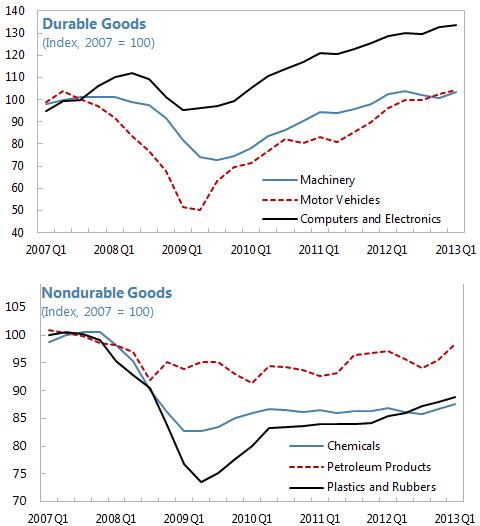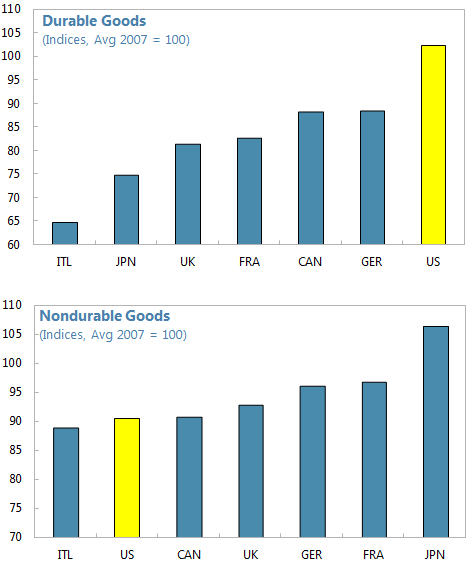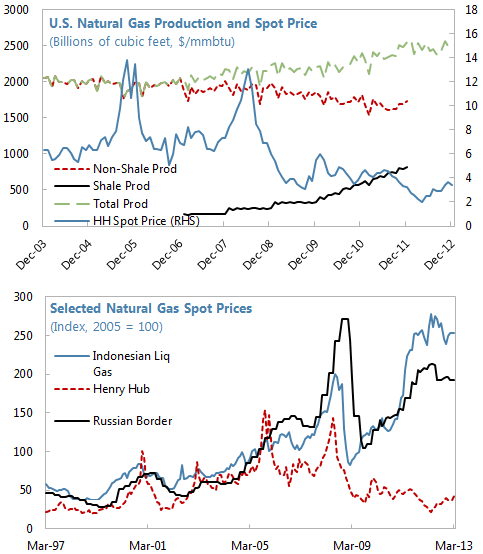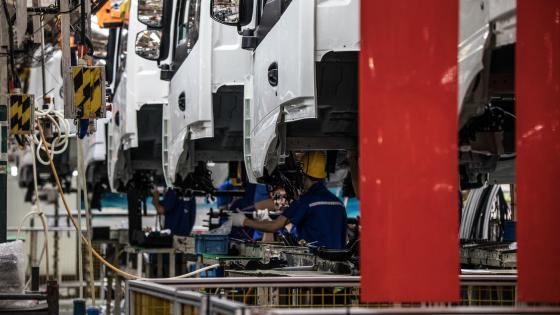Amid increasing anecdotes of a ‘renaissance’ in US manufacturing, many commentators have argued that the sector may contribute more significantly to domestic GDP and global industrial output in future (e.g. Financial Times 2012, New York Times 2012, McKinsey Global Institute 2012, Citi Research 2013). They note a number of favourable conditions – including a weaker currency, lower domestic energy prices, volatile international shipping costs, and significant increases in labour costs in emerging markets – that could support steady increases in US manufacturing output and employment, beyond those that would be expected from a cyclical rebound. The potential for growing demand from booming shale oil and gas activity have also been noted.
In a recent IMF Working Paper, we investigate whether a renaissance is evident in US macroeconomic data, and whether manufacturing could indeed make a substantial contribution to long-term US growth (Celasun et al. 2014).
The facts
The notion of a manufacturing renaissance has been fuelled partly by the rebound in production since the end of the Great Recession. Skeptics of the renaissance hypothesis note that this recovery was the natural consequence of a very strong cyclical decline during the Great Recession. While it is true that manufacturing output declined sharply during the Great Recession, the decline relative to the decline in total output was in fact smaller than in the recessions during the previous three decades. In addition, the Great Recession is the first US recession since the early 1980s to be followed by a significant recovery in the share of manufacturing in US GDP. These observations suggest greater underlying strength in manufacturing activity in the current episode, beyond what would be expected in a normal cyclical rebound based on past US data (Figure 1).
Figure 1. Manufacturing rebound by recession (Index, 100=year before recession, index of the share of manufacturing value added to total output)
Source: Haver Analytics.
Additionally, the aftermath of the Great Recession conceals significant differences in performance between the durable and nondurable sectors. The post-recession recovery has been driven almost entirely by a rebound in durable goods production, which reached its pre-recession level one quarter before overall US real GDP. Nondurables production, by contrast, has largely been stagnant (Figure 2).
Figure 2. US manufacturing, durable vs. nondurable goods (Index, 2007=100)
Source: Haver Analytics.
The strength of the durable sector, in turn, has been concentrated in just a few subsectors. Three (out of ten) subsectors are responsible for the observed rebound in durables: Computer and Electronics, Motor Vehicles, and Machinery. While it is possible to argue that the increase in Vehicles and Machinery is mostly cyclical, Computer and Electronics have exhibited a robust positive trend during the past decade, including through the Great Recession. In contrast, most subsectors within nondurable goods have continued to decline or have shown a slow rebound post-recession, including Chemicals, Plastics, and Rubbers. The exception has been Petroleum Products, which declined much less during the recession and has approached pre-crisis levels (Figure 3).
Figure 3. Components of US manufacturing
Source: Haver Analytics.
Turning to durable and nondurable goods production in G7 countries provides additional insights. The post-crisis recovery in durable goods production in the US was stronger than in other G7 countries (Germany’s recovery had been stronger through mid-2011, but it stagnated thereafter). In contrast, the recovery in US nondurable goods production has been strikingly poor also compared to that in other G7 economies (Figure 4). All in all, we estimate the US share in total G20 manufacturing to have stabilised since the Great Recession, halting a multi-decadal trend of decline.
Figure 4. Durable and nondurable goods manufacturing, April 2013
Source: Haver Analytics.
Drivers of US manufacturing in the short run
Three main conditions have been highlighted as drivers of a US manufacturing revival:
- The US real effective exchange rate has depreciated (become more competitive) over the last decade. Since the recession, the weak level of demand and high cyclical unemployment have contributed to a weaker US dollar, in particular against emerging-market currencies.
- The price of labour in the US has decreased relative to emerging markets. The significant relocation of production to emerging Asia during the 1990s and the 2000s and high unemployment in the aftermath of the Great Recession have resulted in lower wage pressures and favourable changes in unit labour costs in the US over the last decade.
- There has been a significant reduction in domestic energy prices following technological breakthroughs in the exploitation of shale gas. In particular, recent advancements in drilling technology (including shale gas fracking) resulted in a significant increase in natural gas production in the US and led to a reduction of domestic prices, which are currently about one-fourth of those in Asia and Europe (Figure 5).
Figure 5. Natural gas production and prices
Source: U.S. Energy Information Agency.
Can manufacturing make a substantial contribution to longer-term US growth?
The manufacturing sector contributed on average less than 0.2 percentage points to US growth during the last decade. Can that contribution become substantially larger in the near future?
We estimate that US manufacturing exports could provide an outlet for stronger growth in the sector in the coming years. While manufacturing has decreased as a share of US GDP, the GDP share of manufacturing exports has remained roughly constant. If the US keeps its share in G20 manufacturing exports constant through the next decade at the level observed in 2011, manufacturing could add up to 0.4 percentage points to annual US GDP growth – a significant amount.
The contribution of manufacturing exports to US growth would be stronger if the US could diversify its export base toward Asia, where its market share remains relatively low.
Analysts have argued that a further impetus to US manufacturing demand could come from the booming oil and gas production domestically. Our calculations based on the baseline output projections of the US Energy Information Agency, and input-output relationships between oil and gas extraction activities and the manufacturing sector, point to modest contributions for the decade ahead. However, the sectors that would benefit include some nondurables sectors such as chemical products, primary metals, and fabricated metal products, which have not been part of the manufacturing revival to date. The new source of demand for these sectors would therefore mark a positive development.
Main messages
While overly optimistic claims of a US manufacturing renaissance seem unwarranted, some manufacturing sectors have indeed rebounded strongly following the Great Recession. Available data suggests that there are sectors within the durable goods category that have withstood the recession well or have strongly rebounded thereafter, providing hope for a strong manufacturing presence in the US and the global marketplace.
A number of ongoing factors are likely to positively impact the profitability of the US manufacturing sector in the years ahead. In particular, a combination of declining production costs – falling natural gas prices and unit labour costs, along with modest real depreciation of the US dollar – as well as a diversification of exports toward dynamic emerging-market economies could catalyse new investment in the US manufacturing sector, providing a boost to growth.
References
Celasun, Oya, Gabriel di Bella, Tim Mahedy, and Chris Papageorgiou (2014), “The US Manufacturing Recovery: Uptick or Renaissance?”, IMF Working Paper 14/28.
Citi Research (2013), “Is a Renaissance in US Manufacturing Forthcoming?”, 31 May.
Financial Times (2012), “US set for industrial revival, says study”, 21 September.
McKinsey Global Institute (2012), “Manufacturing the Future: The Next Era of Global Growth and Innovation”, November.
The New York Times (2012), “Skills Don’t Pay the Bills”, 25 November.
US Energy Information Agency (2013), “Annual Energy Outlook, 2013”, Washington, DC.











